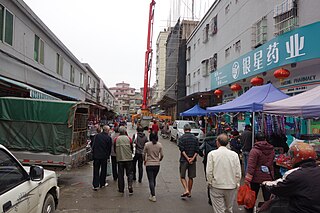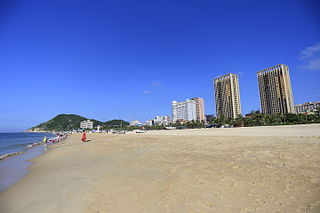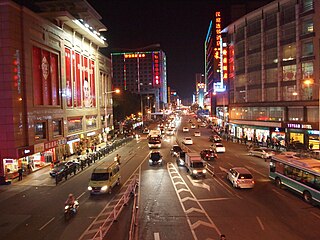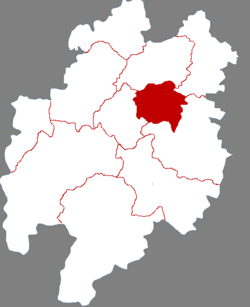
Yantai, formerly known as Chefoo, is a coastal prefecture-level city on the Shandong Peninsula in northeastern Shandong province of People's Republic of China. Lying on the southern coast of the Bohai Strait, Yantai borders Qingdao on the southwest and Weihai on the east, with sea access to both the Bohai Sea and the Yellow Sea. It is the largest fishing seaport in Shandong. Its population was 6,968,202 during the 2010 census, of whom 2,227,733 lived in the built-up area made up of the 4 urban districts of Zhifu, Muping, Fushan and Laishan.

Postal romanization was a system of transliterating Chinese place names developed by postal authorities in the late 19th and early 20th centuries. For many cities, the corresponding postal romanization was the most common English-language form of the city's name from the 1890s until the 1980s, when postal romanization was replaced by pinyin, but the system remained in place on Taiwan until 2002.

Zhenjiang, alternately romanized as Chinkiang, is a prefecture-level city in Jiangsu Province, China. It lies on the southern bank of the Yangtze River near its intersection with the Grand Canal. It is opposite Yangzhou and between Nanjing and Changzhou. Zhenjiang was formerly the provincial capital of Jiangsu and remains as an important transportation hub. As of the 2020 census, its total population was 3,210,418 inhabitants whom 1,266,790 lived in the built-up area made of the 3 urban districts. The town is best known both in China and abroad for its fragrant black vinegar, a staple of Chinese cooking.

Quanzhou, alternatively known as Chinchew, is a prefecture-level port city on the north bank of the Jin River, beside the Taiwan Strait in southern Fujian, China. It is Fujian's largest metropolitan region, with an area of 11,245 square kilometers (4,342 sq mi) and a population of 8,782,285 as of the 2020 census. Its built-up area is home to 6,669,711 inhabitants, encompassing the Licheng, Fengze, and Luojiang urban districts; Jinjiang, Nan'an, and Shishi cities; Hui'an County; and the Quanzhou District for Taiwanese Investment. Quanzhou was China's 12th-largest extended metropolitan area in 2010.

Zhangzhou, alternately romanized as Changchow, is a prefecture-level city in Fujian Province, China. The prefecture around the city proper comprises the southeast corner of the province, facing the Taiwan Strait and surrounding the prefecture of Xiamen.

Foshan, alternately romanized as Fatshan, is a prefecture-level city in central Guangdong Province, China. The entire prefecture covers 3,848 km2 (1,486 sq mi) and had a population of 9,498,863 as of the 2020 census. The city is part of the western side of the Pearl River Delta Economic Zone whose built-up area was home to 65,694,622 inhabitants as of 2020, making it the biggest urban area of the world.

Heshan, formerly romanized as Hokshan, is a county-level city of Jiangmen City in the southern part of Guangdong Province, China with a total land area of 1,081 square kilometres (417 sq mi) and a population of 530,684 inhabitants as of 2020 census and some 200,000 internal migrants. The city is now being conurbated with Jiangmen and so included in the Guangzhou-Shenzhen Pearl River conurbation with more than 65,57 million inhabitants. There are approximately 360,000 people of Heshan origin or descent living in other parts of the world, particularly in the Americas such as Chile, Peru and the United States.

Qiongshan District, alternately romanized as Kiungshan, is one district in Haikou City, Hainan.

Qingyuan, formerly romanized as Tsingyun, is a prefecture-level city in northern Guangdong province, China, on the banks of the Bei or North River. During the 2020 census, its total population was 3,969,473, out of whom 1,738,424 lived in the built-up area made of urbanized Qingcheng and Qingxin districts. The primary spoken language is Cantonese. Covering 19,015 km2 (7,342 sq mi), Qingyuan is Guangdong's largest prefecture-level division by land area, and it borders Guangzhou and Foshan to the south, Shaoguan to the east and northeast, Zhaoqing to the south and southwest, and Hunan province and Guangxi Zhuang Autonomous Region to the north. The urban core is surrounded by mountainous areas but is directly connected with Guangzhou and the Pearl River Delta by Highway 107.

Sanshui District, formerly romanized as Samshui, is an urban district of the prefecture-level city of Foshan in Guangdong province, China. It had a population of 622,645 as of the 2010 census. It is known for the "Samsui women", emigrants who labor in Singapore, and for a large fireworks explosion in 2008.

Enping, alternately romanized as Yanping, is a county-level city in Guangdong province, China, administered as part of the prefecture-level city of Jiangmen.

Yangjiang, alternately romanized as Yeungkong, is a prefecture-level city in southwestern Guangdong Province in the People's Republic of China. It borders Maoming to the west, Yunfu to the north, Jiangmen to the east, and looks out to the South China Sea to the south. The local dialect is the Gaoyang dialect, a branch of Yue Chinese. During the 2020 census, its population was 2,602,959 inhabitants of whom 1,292,987 lived in the built-up and largely urbanized area comprising Jiangcheng District and Yangdong County.

Panyu, alternately romanized as Punyu, is one of 11 urban districts of the prefecture-level city of Guangzhou, the capital of Guangdong Province, China. It was a separate county-level city before its incorporation into modern Guangzhou in 2000. The present district covers an area of about 530 km2 (200 sq mi).

Zhifu District is an urban district of the prefecture-level city of Yantai in Shandong Province, China.

Conghua District, alternately romanized as Tsungfa, is one of 11 urban districts and the northernmost district of the prefecture-level city of Guangzhou, the capital of Guangdong Province, China. Conghua connects the Pearl River Delta with the mountainous area of northern Guangdong. Within China, it is known for its hot springs and lychees. It covers an area of 1,974.15 km2 (762.22 sq mi), with a population of 543.377 in 2006. Its GDP was RMB10.369 billion.

Zengcheng District is one of 11 urban districts of the prefecture-level city of Guangzhou, the capital of Guangdong Province, China.

Jintang County is a county of Sichuan Province, China, it is under the administration of the prefecture-level city of Chengdu, the provincial capital.

Dianbai District, alternately romanized as Tinpak, is an urban district of the prefecture-level city of Maoming in southwestern Guangdong Province, China.

Luoding, alternately romanized as Loting, is a county-level city in the northwestern part of Guangdong province (粤北), South China. It is administered as part of the prefecture-level city of Yunfu.

Pidu District formerly known as Pi County or Pixian is one of 11 urban districts of the prefecture-level city of Chengdu, the capital of Sichuan Province, Southwest China. It was approved from the former Pi County by the State Council on November 24, 2016.





















